Don't wanna be here? Send us removal request.
Photo
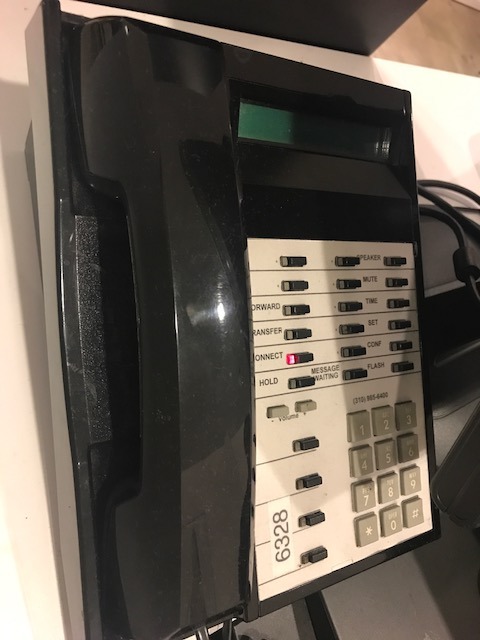
Jai Williams
Cc Week6
TITLE: Connection
Summary: Theatre in Diversion – Evaluating an Arts Based Approach to Combating Juvenile Deliquency by Carol Jordan and Jerry Daday talks about theatre-diversion programs on at risk youth.It shows to have a positive impact on the youth .During the program . Technique skills are taught.
Connect :
I photographed a picture of a telephone because people use phones to connect with one another. In Theatre in Diversion , teaching artists provide a space for youth to connect with one another and connect with the artist. They develop self confidence and human relationships skills like communication and public speaking.
0 notes
Photo
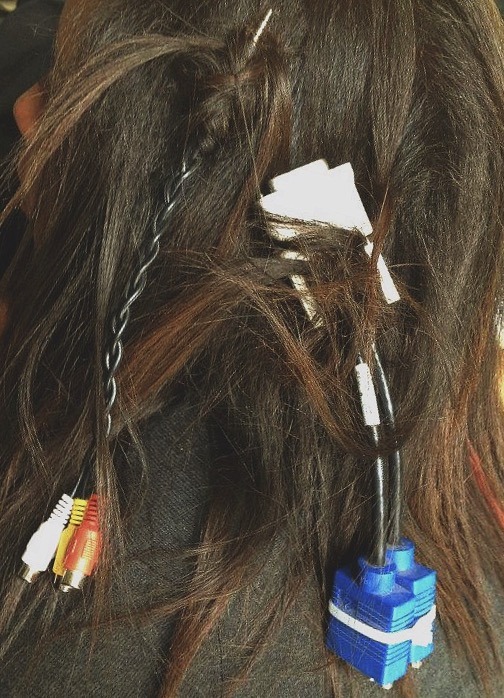
Create Bad Art
The thing I appreciated most about Jaffe pt 3 is his 6 suggestions to shaking up teaching artist work. Even though each suggestions is different, many of them center on not being complacent and stepping outside of your comfort zone. If you usually are safe with your creative expression, switch it up sometimes and do something extreme that most likely will fail. This particularly spoke to me because education in this country is so focused on the end goal and hitting the minimum requirements for a particular course. Teachers especially in public middle and high schools play it safe by only teaching within the bounds of the state requirements, which is why so many students don’t find passion and enjoyment in their studies. Teaching artists have a special role because their boundaries are more liberal so they have the liberty to think outside of possible failure. There is no failure in creating, so who cares if you don’t “succeed”. What’s most is the process, which Jaffe says you should be authentic in. In the Maddie Crum reading, she says that while working with men in the arts program, the one of the most important things for the men to remember is the power they have as creators. As explained by the social learning theory, teachers being able to model how to appreciate the process of creating and how it is in its own way another language, allows the men in programs like the one Crum works with to best feel the implications of their work (especially relating to activities like making portraits). Daniel Grant says it best in Artists as Teachers in Prisons, “ Teaching art isn’t for everyone.” Not everyone has the patience and abilities to fit in the strict guidelines that careful rules that comes with working with correctional facilities. However, the ones who are have immense passion and go on to positively influence so many lives who have often been forgotten. Act V was very inspirational to listen too, and what I took from it was just how dynamic lives can be. There isn’t just one side of a story, and so many factors go into why decisions are made and also how people can change.
My art was inspired by Maddie Crums idea of recognizing the power that incarcerated men have. They might have felt voiceless and powerless, but there is power and a language all of their own when they create. Some formerly incarcerated members of Underground scholars that came to talk to us about how they had to make art out of literally anything they had. This weekend I visited my friend from high school, and asked her to do my hair using whatever tools she had, as part of a social experiment. This was the end result, and even though I can’t really go outside with this hairstyle, it highlighted just how important and powerful the process alone was.
Kauai Taylor
0 notes
Photo
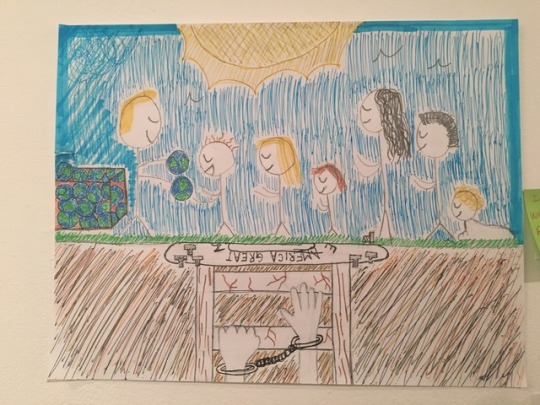
TITLES:
Are Prisons Obsolete? By Angela Davis
Artists Grapple with America’s Prison System by Sabine Heinlein
SUMMARY: The main message I took away this week was about the activism that is starting to surround mass incarceration. Angela Davis’ question is a triggering thought: Are prisons obsolete? Are they something that has long lost it’s meaning, or never even had a meaning to begin with? These articles and links support the notion that prisons have become a business rather than their supposedly intended purpose to reform. People are paying attention to racism, police targeting and injustices and are connecting it to the exponential number of Black and Brown men in prisons. Coalitions have started to form and change will happen in the justice system.
CONNECT: My art connects with the idea of some people being targeted and unable to have the same opportunities as others. In this drawing, I intentionally left the hands climbing up the ladder as well as the people above ground in the color grey to spark personal interpretation. For decades, people have had greater advantages than others and it’s especially true when discussing the justice system. You could be a Black educated, successful man, such as Bryonn Bain, and still be profiled by the police as a Black man committing crimes. We can’t control what we look like, or the stereotypes that have preceded us. We are victims to the very systems we are supposed to abide by. If you look closely at the drawing you will see a screw that has been popped off of the only thing that divides the two levels of the world. Justice will come, just give us some time.
“The World is Yours, if you qualify.” by Isabella Munoz
0 notes
Photo
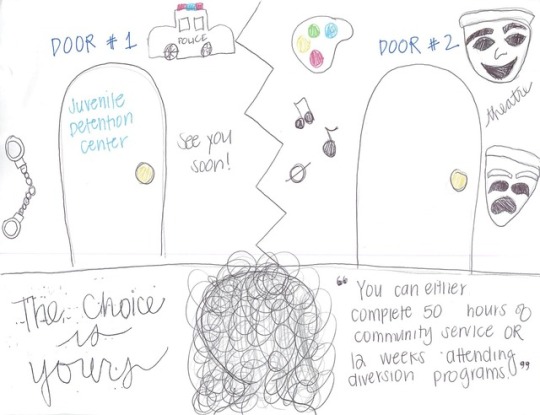
TITLES:
Patricia Minton Taylor Theatre-in-Diversion Program
"Theatre offers alternative to community service for juvenile offenders"
Evaluating an Arts-Based Approach to Combating Juvenile Delinquency by Carol Jordan and Jerry Daday
Prison Policy Report 2016
The Movement for Black Lives website
Creative connection 5, week 6
SUMMARY: 3 of the links provided to us were programs that are offered to young people who commit small offenses. Rather than work tirelessly doing manual labor, programs were designed to allow young people to express themselves in a healthy way by participating in theater programs. These theater programs are proving to reduce recidivism and make a significant change in the attitude of some students. People have better relationships with family, more interest in art, and less likely to bottle things in. Also, the Prison Policy Report 2016 is a website that illustrates the unbelievable statistics of mass incarceration here in the United States.
CONNECT: Punishment is the backbone of rules and regulations. Without punishment, we would live in a world of havoc. Right?
The problem with incarceration here in the U.S. is the exponential number of people that are in jail that do not deserve to be. People are in jail because they fit a description that the cops had for them and became a number when it came to the judge's sentencing. I'm not sure who is making the decision in this drawing, but it depicts a crossroads when being punished. I truly believe these arts programs save lives - no matter what type of art it may be - theater, dance, music, drawing. It all allows expression, creativity and imagination to go wild. These art programs give kids a chance to experience the best things in life - love, family, a life.The art program may be a small time frame, but it can produce a life full of possibilities. The other forms of punishment, community service or juvenile detention centers, lead to repeat-offenses and unproductive busy work.
Punishment doesn't have to be what we've always known it to be. Instead of making each other hurt, we should help each other heal, and these art programs are the first step towards that.
"Meet me at the Crossroads" by Isabella Munoz
0 notes
Text
The following is from a poem by a man named Mike Ogden and published in the book About Time: An Anthology of California Prison Writing.
The Dream:
I dreamed I was in a foreign place.
And yet I I dreamed I was at home.
And everywhere I looked a face
But still I dreamed I was alone.
I felt very close to someone,
But knew I was still very far.
Then I reached out to grab for anyone,
But found only steel bar.
Quite different was this place to me,
Square rooms with knobless doors.
And everywhere a sense of apathy,
And everywhere shiny wax floors.
A nightmare! In exciting measured spaces,
Set pensively, or perhaps to brood.
Then I awoke. And hoped for
And hoped for a visit that day.
Mike Ogden
From the same book, I found this poem, signed only by “Jackson.”
Ship at Sea
May-Day:
Men walk around the yard under the gun.
On the outside lovers hug and kiss under a tree.
The men share their photos of a beautiful wife and lovely son
as their minds tick:
they can’t resist
the million-dollar question:
When will they ever be again free?
Their sailing is rocky,
Like that of the ocean and its waves.
On a prison ship anchored forever,
yet slowly sinking, the prisoners are crying…
Screaming!
May-day
May-day!
Jackson
In the first poem, Ogden seems to be, at least in some part, experiencing and reflecting upon much of the absurdity of being confined. He does not imply that he does not belong there and incarcerated, rather he sees the trivial upkeep and rehabilitation of the prison itself when mentioning the apathy towards the incarcerated, yet the fact that the floors are shined. He also speaks of loneliness in regards to being so far away from someone, however even if he were not physically far away, he realizes he must see through bars. This is mentioned in his dream. He speaks of reaching out to someone, yet only finding steel bars and his confusion of a room with no knobs (identifying a cell). He seems to be at odds with the effect of living as a free man and the small things we take for granted with that freedom, such as being able to reach for someone and not being abruptly blocked by steel bars or opening a door from the inside and leaving when we would like to. He also speaks of the oddity of a room without door knobs to exit. His mind is struggling with the duality of freedom and isolation at the same time. It is probably easy to forget the things we have in our lives, especially when not only our material possessions and family and friends are taken away, or rather a prisoner is taken away from these things.
In the second reading of poems I did, which came from the same book, the poem seems to be about the life “Jackson” is acutely aware of, yet, still writes of the simple pleasures of the outside world of which he is also keenly aware. When he describes walk in the yard of the prison, it is done so under the threat of being shot if one were to step out of line. At the same time, he references those outside of the wall people can express their love for each other with no penalty and under no punitive circumstances. He mentions the pride fathers feel when showing to their friends in prison pictures they have of their families, but despite the pride, in the back of every man’s head, is the thought of when will they be reunited with their families. When speaking of the rocky sailing, he also points out that the prisoners are not afloat at sea aimlessly and lost. He reminds the reader that despite the horrors, which he equates to a rocky sea, in fact they are actually docked and not lost at all. However, the fact that they are not lost and are docked does not mean that psychologically these men are drowning from the despair of never getting out. Family and loved ones and freedom can be right outside the prison door, which can be measured in feet, yet they are a million miles away from exiting that very same door.
When comparing these two poems, there are some striking similarities. The descriptions of their cells may differ, or the way they even view their own confinement. The idea that both of the men who wrote these poems, likely never knowing each other or for what they were accused and convicted of is also evidence that the prison experience seems to share some inherent similarities. However, they can relate to an understanding of an outside world, where they can literally often see it, through a fence, though under the condition of armed guards; or the fact they often can’t see friends, family and others of those who are close to these men—unless they are being monitored. They both seem to be aware of this idea of having their loved almost close enough to reach if they weren’t hindered by their bars.
Jack Flynn
0 notes
Photo

Summary: Are Prisons Obsolete?, by Angela Davis, one of the first things she does is emphasize a concern about the increasing number of prisons in the U.S. She, in some ways seems to understand the paradigm that exists, which states that if a law is broken, and it requires a punishment, that jails and prisons are the default method of punishment and rehabilitation. To say she understands it, is not to say that she agrees with this paradigm. She mentions that the death penalty is being abolished in more parts of the world, citing mostly human rights. While the abolishment of the death penalty is somewhat easier for people to understand, she analyzes the abolishment of prisons under the same microscope. Are prisons rehabilitating the incarcerated, or are they simply denying human beings a lack of rights, including keeping them away from the world until an essentially arbitrary set of years of confinement has passed and these former inmates are sent back out into the world, with no real coping mechanisms to adjust to a non-incarcerated life.
In the piece Artists Grapple with America’s Prison System one of the themes discussed is the idea of slavery as it was in the American South leading to the U.S. Civil War and how inmates are used as a potentially free workforce. In fact, Keith Calhoun says in the article that “The prison System survives because of free labor; that lets you know that slavery still exists.” In equating the two forms of labor, it makes for a powerful message to those who are unaware of the way many prisoners live their lives behind bars. Is it fair to expect heavy labor to those who are already being denied many rights? How far can a prisoner be exploited in the benefit of others?
My image represents the message that Angela Davis was trying to portray in her query, Are Prisons Obsolete? I drew the question mark behind the bars as not to reflect an incarcerated individual, but to imply that prisons are coming under increasing scrutiny, and for a good reason. I a perfect world, a person who commits a crime may be able to go through a program that is designed to rehabilitate them. As it is now, there is little to no structure for those who are confined to a cell. When these people do return to the outside world, they are often not capable of assimilating back into society. A lack of education, and the fact that a criminal background check has showed a red flag are all things that can lead to recidivism.
Jack Flynn
0 notes
Photo

In Jaffe’s, How Will I Teach, the subject of teaching is, in a way, stripped to its core to better understand how to teach better. This does not, however, imply that it is teaching students a lesson, or even teaching teachers how they should approach their students, or their students’ work. In fact, at one point it is pointed out in an example in which Jaffe says, “You can walk into a classroom, show some kids how to hit ‘record’ in Garage Band and then step back and see what happens.” This seems to imply a method of teaching in a very hands-off manner. By doing the very bare minimum, sometimes, in this case, music can be created without any outside input from an authoritative figure. In an interesting note, Jaffe is describing how that despite their being many style of teachings based upon the teacher and based on the medium of art as well. He also explains that there are some characteristics in which all mediums of art share. What is meant by this, is that when it comes to teaching, there are some inherent similarities that cannot be avoided. Paradoxically, while this is true, it does seem to get in the way being completely free from constraints.
One of the biggest problems that is constantly being addressed is how to punish those who have committed crimes, especially juveniles. The ideal outcome of any program a person who is incarcerated is rehabilitation. So, in Kentucky, where the Patricia Minton Taylor Theater-in-Diversion Program takes place in Western Kentucky University’s Department of Theater and Dance, the sociology department in the same school as well as the Administrative Office of the Courts, takes those who are still juveniles who have committed low-level offences, such as explained by the university’s website, underage drinking, truancy or curfew violations. By taking these kids, who may, or may not be at risk youth, and getting them involved with the university’s program (diversion) and in a way in which they can be creative and actually produce something that will give them a sense of ownership. It should also be noted that the end result is not just to divert these kids from committing more crimes, at a worse level, but to prepare these young men and women to perhaps embark in a life of art.
My image of the initials for Western Kentucky University working with the Administrative Office of the Courts shows that corrections, even if for low-level offences, can be not just punitive, but creative. The fact that Western Kentucky University Theater-in-Diversion Program was willing to work with those who may have broken the law, but had not committed serious felonies, shows a desire to divert kids who may be in at-risk situations to think about taking another route. This also doesn’t mean that all who participate in this program are intended to go into theater, but to show them that there are different roads to take and no one is beyond helping.
Jack Flynn
0 notes
Photo

Martin Mitchell
Rhythm Machine: Theatre, Prison Community, and Social Change
Right out of the gates of Mitchell’s piece, he discusses the attitude that some of the youth in the Louis Gossett Jr. youth residence have towards the idea of respect. Further ideas, such as “do the right thing,” be tolerant of others” and “take responsibility for yourself and your actions” also were yawn-inducing exercises for the young men. A new method of addressing some of these concerns and ideas was to use the young men to physically “mold” each other in what they perceived to be the most accurate description of words or ideas, such as the representation of respect and the opposite of respect. As statues in the real world don’t speak, neither did the clay molds of the models speak. However, the young men who were molding their fellow inmates could not speak either and had to resort to hand gestures to address any ideas about positioning them, or if they needed more people to be involved in the “statue.” In some ways, the amount of thought and creativity it took to conduct an exercise like this without using verbal cues seems to present a challenge for the kids to participate in. They are able to address and express the way that they feel as well as doing it in an interactive way. This also requires teamwork, which can be hard for some to do as many of these young men may have had to rely only on themselves.
The Knotted Line is an interactive site that allows the user of the computer to drag predetermined images away from their original position, and they reveal a world beneath a world. In some cases, images that are all shaded in black also imply that the image beneath them might be easily identified, e.g., a benign broken latter, when moved, becomes an increasingly higher column of incarcerated people. Conversely, when an image of bars is moved away, behind it stands what appears to be a politician holding a glass of champaign. It would appear that in this interactive piece that the idea of a judging a book by its cover is a cautionary tale.
The Prison Industrial Complex is quite overt in its message. It outlines the many ways that can land some people in jails or prisons. This image shows that anything from legislative pushes for maximum sentences for any crime, to homelessness can feed into the machine. Essentially, those who are in need of food or shelter may engage in activities to rectify their situations, however, if these activities are deemed illegal, these people are put into jail or prison based on the fact that they were so desperate, they were willing to cross a legal line to protect themselves or others. One of the biggest mistakes the US prison system has made is the private prison system. Their entire income, comes from people sentenced to their prisons, as well as maximum sentences. Education, lack of healthy food, homelessness, police brutality, xenophobia are all variables that fit into the prison industrial complex.
My piece of art refers to the idea of using models and molding them into an expression. This lump of clay represents the students who are being molded, and the word respect written on the clay itself represents what the student is trying to portray as they find it more and more difficult to use words to express themselves. So a visual representation, as well as a rule that the artists could not speak allowed them to create and think critically, yet in an arts-based medium.
Jack Flynn
0 notes
Link
Title: “When Will You Come Back?”
(Week 8 Reflection - late submission)
---------------
Lyrics:
Born in 98, 18 years old,
Next court date, expect to be told,
I'll be behind bars for two lifetimes,
Ain’t that something, for a couple of crimes.
Product of your environment,
Is that why you get to leave?
Could you live like me?
It’s hard for me to believe
When will you come back?
I enjoyed your arts program.
Let me help you put away chairs.
Thursdays and Fridays, they don’t compare [shoutouts Frank & Carlos]
We met you once today,
perhaps you won't return.
Until September, or later,
I hope you’re still here when the court adjourns.
------------
Summarize:
This late creative connection was developed after our Friday visit to Barry J. Nidorf Juvenile Hall. When we were there wrapping up the day’s activities, one of the youth named Carlos asked Laurel when we would come back. Laurel told Carlos about the summer fellowship and its related programming, but Carlos adamantly asked when we would physically return to the Hall. After concluding that the classes wouldn’t be returning until next Fall quarter, or late September, Carlos replied that he might not still be at BJN.
After a rewarding day of arts activities and discussion, this was definitely an eye-opening, first hand experience of the realities of the school-to-prison pipeline, the prison industrial complex, and the issue of mass incarceration/ juvenile justice system summarized in Carlos’s one question. I felt particularly inspired to work this content into this quirky song that takes particular influence from Girlpool - I’m not sure if there is any explicit reason for this connection, but the musical qualities scream angst.
Connect:
Larry Brewster’s article, titled “The Impact of Prison Arts Programs on Inmate Attitudes and Behavior: A Quantitative Evaluation,” is practically a lengthy statistical analysis of the positive effects of arts programming in correctional institutions. Much of the article feels like common sense to us after taking this course, but I realized that it is important to put these statistics in perspective; if we didn’t have the knowledge gained through the class and the numerous texts throughout the quarter, many of these numbers would be perceived as ground-breaking evidence of arts programming’s potential for reducing discipline and recidivism. Arts education, both in those with prior arts experience and those without, was found to increase “life effectiveness skills” (a somewhat problematic term, but for the sake of this article it is constructive) such as intellectual flexibility, self confidence, achievement motivation, time management, emotional control, social competence, and active initiative.
One aspect from the article I would like to point out is that the studies found “inmate-artists were far more likely to pursue other educational and vocational programs than inmates without arts experience or education.” I found this particularly inspiring after meeting the youth inmates at BJN, because I hope that they continue to find inspiration and mental stimulus through arts programming whether they remain in BJN or are transferred to adult facilities. Laurel put it best when she told Carlos that he should remain in touch with the program in order to hopefully develop a program at whatever prison he would end up in - the transfer of power and determination from Laurel’s hands to Carlos’s was visibly noticeable, and proved to be a tangible empowerment through the hopes of arts accessibility.
“The Beginners Guide to Community-Based Arts” was a relevant read as it brought up many facets of community-based arts programming, with direct application to the first hand experience of teaching artist Rhodessa Jones. Jones worked as a dancer/ aerobics art teacher for the California Arts Council, and she mentions that her goals included “meet(ing) their bodies with their minds through conversation, improvisation, and exploration that directly connects to their lives.” The combination of aerobics with readings proved to stimulate many of the incarcerated women to physically activate their bodies, which in turn influenced activation of their spirituality. The connections between the spirit/ mind and the body are often overlooked, and spiritual conclusions and thinking are catalyzed when the psychological structures separating the two are broken. This is an important aspect to remember when creating programming for incarcerated folks, and Frank summarized it best: Thursdays is for the mind and thinking, and all that other shit. But Fridays is where you get to do stuff, its more fun, and you start making connections with other people.
I found that the reflection section of the Development Guide was particularly important, as it was one of the few sections that places more pre-determined emphasis on the facilitator and not the students. By this, I mean that many of these standardized teaching guides often enforce subconscious means of pre-determining everything, although in reality teaching is very improvisational and requires facilitators to nurture students into a relationship where the subject/ topics are of mutual interest to everyone in the learning environment. This is also important to consider when developing correctional institution programming: how relevant is Plato to incarcerated youth? Only as relevant as you can express your own personal interest in the subject!
Ellington Peet
0 notes
Photo
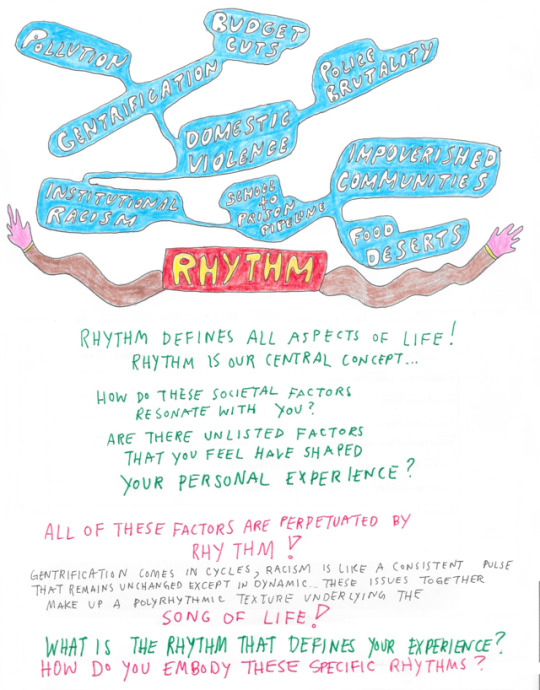
Title: Rhythm Is Our Central Concept
(Week 7 Creative Connection - late submission)
----------
Summarize: A quote from the Jaffe text particularly stuck out to me when creating this handout: “The goal is to make concrete connections between one’s own expertise and interests as an artist and a person, and ideas about what and how to teach in one’s medium and across disciplines.” Jaffe’s example of “pulse” made me realize that I take a lot of interest in urban planning and the effects of urbanization and gentrification on communities in Los Angeles, in particular. I also remembered a question that one of my best friend’s mothers posed to me at a holiday dinner several years ago: “what is the rhythm that defines the world in 2015?”
Although there is great potential in analyzing every individual’s “hobby” interests ranging from things like sports to movies, I feel that there are interests that transcend everyday thought that are worth investigating. Everyone’s individual experience speaks to negative influences that have defined the conditions of their environment. The results of these conditions are one’s present position; in the case of incarcerated folk, many of these negative factors have explicitly led to their incarceration. With this in mind, I thought it might be interesting to have individuals look into the respective rhythms of these issues, and how change on both a personal and communal level can disrupt these rhythmic cycles and perpetuations.
Connect: Jaffe stresses the importance of learning something from what you do in order to better yourself, thus influencing and bettering your teaching practice and the educational experience of all individuals involved. I agree with his argument, as real interest in artistic practice is only truly effective when it can be tied back to one’s personal experience and the need to express oneself. Maddie Crum’s article, titled “How A Prison Art Program is Promoting Self-Reflection in Incarcerated Men,” explores this further when she considers how time is perceived differently by individuals inside and outside of correctional institutions. There is a specific quote I would like to mention: “Time is a very important concept for many of the incarcerated participants. Although time in the long term is often portrayed in a seemingly never-ending way, time in the short term is actually hard to come by.” I thought this was strikingly powerful, as it tears down our outsider assumptions of how inmates view time inside. This also applies to the rhythm of life, but I did not specifically explore rhythm’s relationship with time in this creative connection because I touched on this theme in a previous creative connection.
In the article “Artists as Teachers in Prison,” I took interest in the theme of connecting Civic engagement with Arts creation. We have touched on the problematics of inmates doing “productive” labor to better the community, as it leaves a lot of room for labor exploitation. Although it can be argued that it is better for inmates to do something rather than nothing, we must always remember that the inmates are people too, and enforcing borderline slave-labor does not contribute to empathy building or emotional and guilt rehabilitation. In contrast however, allowing inmates the opportunity to contribute directly to their own communities through mural painting and similar activities builds agency, while simultaneously working to destroy the cyclic rhythms that perpetuate many environmental issues like pollution, food deserts, and poverty. Through connecting arts education to civic engagement, teaching artists and inmates alike can work together on a mutual social level to break down the rhythms that perpetuate many of the conditional issues that enforce the prison industrial complex.
Lastly, the Hamlet podcast titled, “Act V,” was truly inspiring and equally stimulating. I found interest in the section where Jack Hitt viewed the inmates records and experienced immediate trauma in response. I can’t speak for how he must feel, as I won’t know the records of the inmates I interacted with at BJN, but it does feel like this is also a level of privilege that we can enjoy as free outsiders. We can choose what information we want to know or don’t want to know, as well as we can remove ourselves from the presence of these individuals whenever we like. However, it is our duty as teaching artists and activists to break down these barriers, and continue contributing what we can in order to help cleanse these individuals of their stigmatizations on a genuine, creative basis. It was definitely emotionally rousing when Jack Hitt stated that “this whole night, including the cast party, is just another rehearsal,” as it puts in perspective the balance of temporality that these inmates experience while locked away for extended periods of time. Although these programs feel like they may last for weeks at a time for us, these classes may just be brief episodes in the broader picture of these individual’s sentences, and therefore are just slight hiccups in the prolonged rhythm of their incarceration. However, these hiccups are like the wrecking ball prodding against the building that will soon be demolished, as we are entering into these institutions and hopefully inspiring incarcerated folk to continue participating in these activities. We are all working to disrupt these problematic rhythms that have become so entrenched in our society, and therefore we must all continue to “exercise your mind, (or else) you start losing it.” We can provide time, or rhythms, that allow incarcerated folk to feel human for “a little bit,” and this is what makes our work all the more important.
Ellington Peet
0 notes
Photo
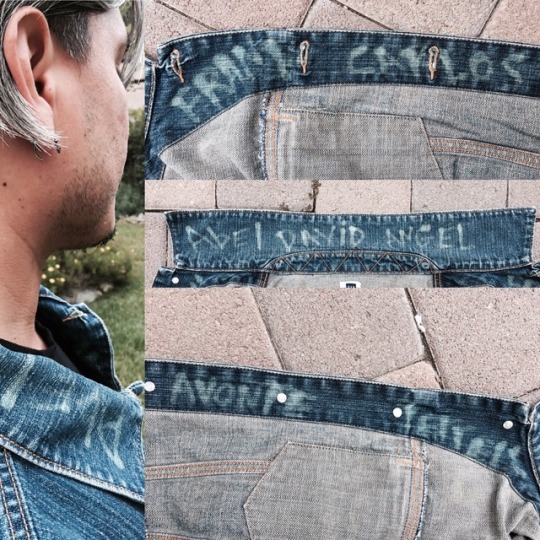
Untitled
*week8
by Raymundo Baltazar-Flores
Preparing to enter a Juvenile Hall can be a bit strange, however, it is very important. Now more than ever, I fully understand why it is important to do so, primarily, as a safety procedure but also as a personal gesture to the inmates’ space. You are entering a space that is full of embodied knowledge and realities. Most of which can never be fully understood. Personally, I had no idea how the inmates do their time, something that was mentioned in the article by Maddie Crum, How a Prison Art Program is Promoting Self-Reflection in Incarcerated Men. Crum mentions that the concept of time is different for inmates. In a way, I understood that concept after visiting Barry J Juvenile Hall. My concept of time was understood and short, relative to the time the inmates experience. The best way I can explain it, is that I knew that I would ultimately leave by Noon. And I felt as if the inmates also knew it.
I was most impressed by the inmate’s welcoming disposition. The inmates’ diversity, as mentioned in Daniel Grant’s piece, Artists as Teachers in Prisons, became apparent. However, just like the article, I do not mean Race but rather language, learning levels and skills. The inmates were articulate, funny and insightful. Honestly, after talking with Carlos, the inmate that sat with my group, I felt less strange and nervous. I felt that there was a real willingness to meet, to talk and to spend time together. I learned something about me that day and like what is mentioned in This American Life’s recording by Jack Hitt, I discovered something about myself. Through the inmates, I learned that we share a willingness to learn. School and education seemed to be very important for them too and it is in such concept that I decided to create this week’s creative connection.
Further, by reading How Will I Teach (part 3), the concept of translating your curricula and lessons is mentioned. That type of translation is needed, because the day before, during class time, we came-up with our lesson. And once we entered the Hall, my group had to make a few adjustments. Personally, I felt nervous. I kept on thinking about the lesson and the Guideline & Rules for Visiting LA County Juvenile Halls. I was a bit overwhelmed. I wanted to not take too much space, I wanted to enjoy and I wanted to make a connection. However, it all felt too short and fast; perhaps unlike something they felt. After all, to assume that my short time with them amounts to something larger than what it was, might be a stretch. By reflecting on the video titled, Shocking Facts About the US Prison System: Animated Infographic, 6.9 million adults are currently living within a correctional facility. And I only had met David, Carlos, Avonte, Frank, Terrel, Angel and Abel. Seven individuals. A small number. However, the exchange and experience was gigantic.
My creative connection tries to maximize that short-lived experience.
Bleaching their names onto cloth, render an element of fading - I am trying to prolong: our time, the memory, the embodied experience.
With this action, I’m trying to ensure that I do not forget. Through this jacket, I am creating a new guideline that should be utilized post Visiting a Juvenile Hall.
0 notes
Photo
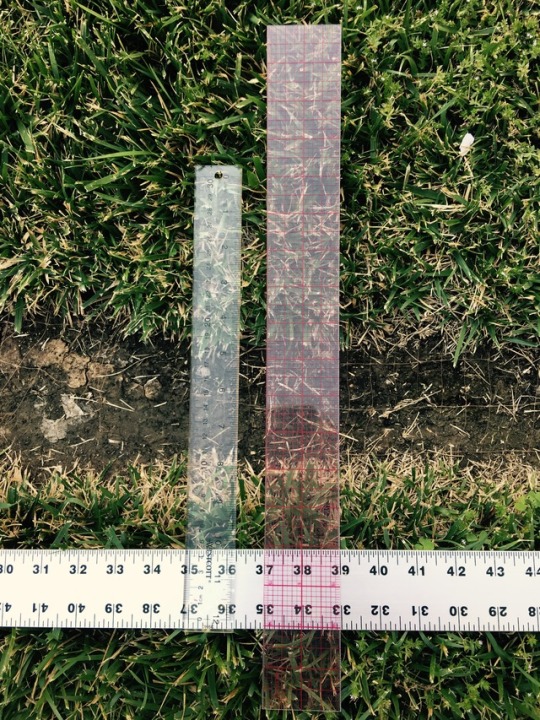
a clear pathway: the creative economy?
I have heard - within the last 5years- the use of such phrase as an extremely positive concept. As if the “creatives,” those that make-up this specialty economy, have arrived and everything will now be forever green.
I am extremely cautious about its positive and cheerful evolution, most especially realizing that I am directly or indirectly a part of it. But, what is clear to me, is that such creative-boom has brought forth a few issues that need further exploration. However, I am not clear about the creative-economy’s long lasting effects, most especially within the realm of education.
The second part of “How Will I Teach?” talks about the “concrete” ways one can teach and how “the way of doing” is imperative to teaching. Based on the idea of classroom management, I began to think of the ways we- society approach the concept of doing. My photograph tries to visualize such idea by using clear and solid rulers. The rulers are measuring the bare pathway; at the same time, the rulers show the distance between the two greener pastures. By placing the rulers next to the bare pathway, my attempt is to show that the distance is the same based on the three perspectives. The measurements provide guidance, but they do not provide the seeds that could help the grassless pathway to match its neighbors. My argument, to use the growth and impact of the creative economy as a primary factor for the benefits of creative arts based programs that help individuals like Johnny Ortiz, is not fully accurate. Just as it is not fully accurate to assume that everybody can have a ruler to measure at all.
As mentioned in the article by SCPR, Johnny Ortiz found a clear pathway based on the help of others. However, it is the boom of creative, arts programs that has also created the opposite results. I could not stop thinking that Johnny grew-up in Highland Park, a new mega hub of displacement created by the arrival of the creatives: the members of the Creative Economy. Perhaps a stretch, but it could be that those who helped Johnny or are helping other individuals, are also actively displacing others from their own neighborhoods. Based on the story, written in 2016, to which at such time, the displacement of families had not only been occurring for more than 5 years, but also to which time reflects the process (gentrification) as almost complete. I cannot help to wonder, would Johnny have been impacted by such? Would Johnny’s family have been displaced or is Johnny now a part of such creative economy? So, my question is, why is the SCPR article highlighting (a bit too much) the benefits of such creative boom, which includes the growth of teaching artists. Once you look at the Otis’ findings, there is no mention about who really is a part of the creative economy? I believe the reason was to avoid the “race talk” because as Bryan Stevenson said on his TED talk, “we have a hard time talking about race.” And based on the logos of the corporate funders of such study, I am certain that race was something they avoided. In my opinion, based on other research, the creative economy is indirectly assisting the stigmatization of minorities; and if minorities are being pushed from their neighborhoods, will the individual that goes into prisons or juvenile detention halls represent the faces of those that already feel disenfranchise. In other words, if the incarcerated populations are primarily minority groups, I would argue that at some point, the artists that go into these spaces must and need to reflect the inmates’ population.
Further, through the array of videos from the TEDx San Quentin, I found another element to explore. Based on the wide-shots of the audience members, I noticed my above argument on display. The majority (assuming) seem to be predominantly white. Therefore, I have come up with a conclusion. Personally, what these readings and videos highlight, is that the community of individuals/partners working to create, support and reimagine Arts Education for Incarcerated individuals, must begin to embrace diversity and should begin a campaign to bring more POC into its practice.
by Raymundo Baltazar-Flores
0 notes
Photo
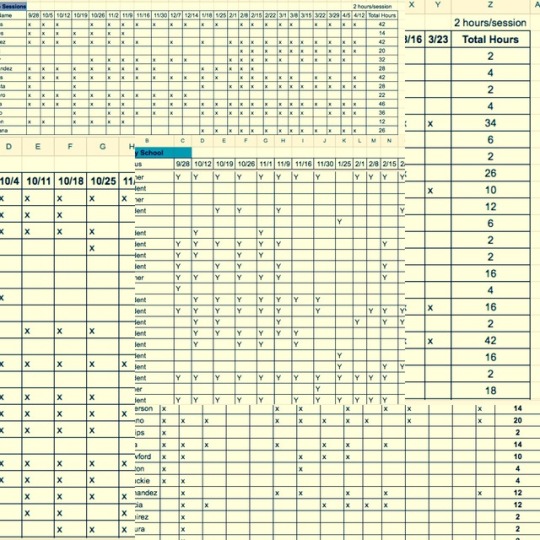
Assessments.
by Raymundo Baltazar-Flores
*cc, week 6.
How Will I Teach (part1) by Jaffe, et al., highlights an element that –personally, - has changed the way I approach arts education. In other words, throughout the article I noticed that no matter how gifted or well-balanced an arts lesson can be, it requires the integration of data analysis. Data collecting, in my opinion, has become a major part of the life of an arts educator. Throughout the article, the concept of reaching expectations and accomplishing goals, driven by “pre-existing ideas about…outcomes have been complicated by the institutional, political and economic context in which we work” (3). This article got me thinking that though many of the initial goals to provide “arts,” as either during-school or afterschool initiatives (to keep children safe during after school hours) might have been a good idea, but at some point, data needs to be prioritized. It is through data that projects, lessons and new ideas get implemented and shared.
And it is within those ideas, that my collage attempts to visualize or problematize. With my work, I try to explore the following questions:
How can we capture data without de-prioritizing the Arts?
Can Data-gathering coexist with Arts Education?
Can Data proof its impact?
Is Data, Art?
Can Data be an ally?
Data is an ally to creative alternatives that can help fight against the ongoing dehumanization of incarcerated peoples. Patricia Minton Taylor Theater-in-Diversion Program is a good example on how data and testimonials help to create a narrative that subsequently supports creative alternatives. It is through data that we can directly point to using preforming arts, instead of incarceration, to support at-risk individuals. (Though, I find the term “at-risk” to be an offensive term). Further, the College Heights Herald piece, through the example of theater as an alternative to community service for juvenile offenders, also supports the importance of arts education to create cooperation from other disciplines that can also aid in the healing process. The Arts can help built bridges between other disciplines, something that rarely gets mentioned.
However, Project MUSE’s piece by Carol Jordan and Jerry Daday warns that the “increasing emphasis on data-driven assessments” can harm the ethical foundation of arts education. It can harm these types of ‘creative alternatives’ by creating a simplification through numbers, charts and infographics. Therefore, if an arts program or an alternative outlet does not “perform” in an ideal manner, the assumption can be that it has not help anybody. When in fact, the greatness of Arts based pedagogies is that within its unique concept, autonomy and freedom are required. To assume that data trumps one individual’s unique transformation is problematic, because solutions are not a one size fits all concept. Most especially, when information such as the one that is shared through the Prison Policy Initiative’ “mass incarceration” graphics, highlights that most juvenile offences are nonviolent and should be treated differently. When multiple traits can help identify an “at-risk” individual, we must have just as many alternatives to help them shed such stigmatizing identity.
0 notes
Photo
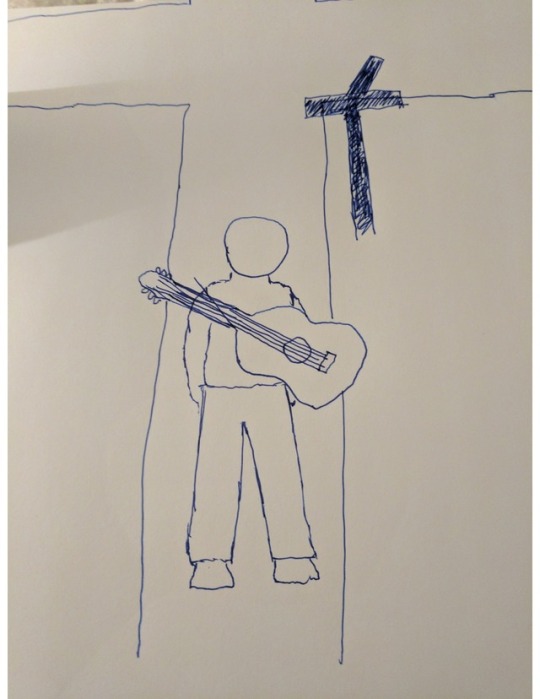
My art was based on the reference used in the Beginners Guide to Community-Based Arts. The image is in response to the idea of the Crossroads. Crossroads, whether taking about Faustian deals between humans and the devil in which the human sells their soul in order to become rich, talented, successful. etc. also represent one of the most enduring legends often associated with a crossroads in the American South in the early 1900s where someone could go to earn a musical instrument from the devil. One of the most famous cases that is mentioned is that of Robert Johnson, who went to the crossroads in Mississippi to learned to play the blues guitar better than anyone else alive. Deals with the devil in return for something that a person may never acquire are not originally from the American South, nor did they always represent musical talent. The idea of the crossroads, however, does have an important message in it, though. A person walking along a road who comes across two roads intersecting, in a way, represent the choice or choices a person must make that will lead to the way the rest of their lives are lived. That person may decide to stay on the same road they are on and continue with their lives along that path, yet they can also take the left or the right turn and now travel upon roads which they are not accustomed to and which may alter their lives dramatically for better or worse. Sometimes people will say the devil you know is better than the devil you don’t. I find that to be an apt description here. Even if the person stays on the path they are on and even if they feel that that path is what makes them the somewhat unhappy, yet is tolerable, it still may be the better choice given the possible alternatives. As humans, we have the agency to make our own choices about how we wish to live our lives, but we also know that there are consequences for living a life based on decisions made in one’s past that brought them to where they are today. The thing about agency in the legal system is that it often allows someone who chose the wrong road to atone for the choice they made and change their lives and actions for the better.
In The Impact of Prison Arts Programs on Inmate Attitudes and Behavior: A Quantitative Evaluation, the focuses of different disciplines in the world of art are applied to those who are currently incarcerated. A study of how these programs may benefit inmates both in and out of prison and the efficacy of this type of rehabilitation is conducted. Of note, is the fact that not only is the practice of fine arts a successful tactic for increasing the level of skill and desire to engage in different forms of the arts, but it also increases the potential and actual academic performance of those inmates who are exposed to it. As Larry Brewster pointed out that “For example, arts education can lead to improved writing skills, greater intellectual agility and creativity, motivation and enhanced performance in other academic disciplines (pp.2). It is also pointed out that in some cases, the arts can help an individual who is incarcerated (and would seem to lose their perspective of an identity) find their identity, which may have been lost to them when they were put into the system.
In the Beginners Guide to Community-Based Arts, the central theme seems to be about how the arts, or what we may perceive as arts have been used much longer than we would generally think of humans knowing how to communicate in an efficient manner. It is explained that “cultural codes, such as signs, symbols, rituals and stories range from communication through signs, which are still used today in the form of hand gestures mainly. The expression of abstract thought, or even recalling an event that took place or an event that did not take place, but can serve as a metaphor or a cautionary tale in the form of a story in books, newspapers, internet reporting all have the same roots and points as they did when mankind first began expressing a person’s feelings, warnings, observances, etc., in order to form a more cohesive society, which is why, though man cultures have never come into contact with others, they can all still communicate with each other without having to learn it form another culture.
In Development Guide for Excellence in Teaching Artist Practice published by the Lincoln Center Education it gives a rough layout of the steps that a teaching artist uses in their practice. One of the aspects about teaching artistry that I was interested in was the aspect of the teaching itself also included learning that the teaching artist engages in with their student, allowing for a more in-depth experience for the TA and the student or students to immerse themselves in. There is a spectrum of the level of efficacy that can be assigned to a teaching artist and how well they not only taught based upon their own experience, to inspiring the drive in students to follow along with the program that allows the student to engage in their work in an exclusive or personal way that they wish to proceed in their learning. For example, the table entitled, “Artistry,” the top row goes from “adequate” all the way to “ideal.” The basis for the differing levels is not simply which teaching artist had the most engagement from students, but how much the students engage with the TA. For example, adequate, while by definition means, getting the job done, in this rubric, it is defined by the student imitating the TA. There is still a learning process here, but it could be more engaging for the TA and the student. On the opposite end of the spectrum, the ideal scenario revolves around a TA who goes out of their way to create a certain situation in which the student is not imitating what the TA did, but using the act of performing to not only express how they feel, but also creating their performance on their own, which could possibly lead to a feeling of accomplishment where there was none before. This sense of creation allows the student to feel a sense of ownership, and that type of ownership can never be taken by anyone.
Jack Flynn
0 notes
Photo

Jai Williams
Title : Development
Summarize :"The Impact of Prison Arts Programs on Inmate Attitudes and Behavior: A Quantitative Evaluation” by Larry Brewster talks about studies that have shown that inmates can benefit in a number of ways when exposed to the arts.Arts education can help those struggling with issues of self- worth, confidence and empowerment.He continues to explain that interdisciplinary research suggests a strong linkage between the development of the right brain and arts education and practice, which in turn, leads to higher-order thinking skills and greater emotional self-regulation. Furthermore , there is evidence that a well-developed right brain correlates with focused attention, creativity, intellectual flexibility, patience, self-discipline and the ability to work with others
Connect :This photo connects with the reading because it portrays that with the inclusion of arts in jails, there will be change. Arts continue to show that humans benefit from it and become overall better. The photo depicts the overall change once one comes in contact with the arts.
0 notes
Link
Link above~~
This week’s readings were both informative and fun to read. Beginner’s Guide to Community Based Arts was especially interesting due to its formatting and almost scrapbook like feel. The way it was categorized, with sections titled “Community as Culture” and “Art is Information” felt the entire time I was reading it like such a perfect tool for every teacher for how to mesh creative practices and exercises with other forms of community projects and teachings. The reading itself did not take itself too seriously, and is a product of smart creative information. Its specific section on culture codes I found to be interesting, where it talks about people taking back “cultural codes” away from the private and back into ethnic and social relationships and community building. It additionally repeatedly asks for reflection, something missed or deemphasized often I find in these sort of guides.
The Impact of Prison Arts Programs on Inmate Attitudes and Behavior: A Quantitative Evaluation looked at statistical data regarding arts programing in correctional institutions, the most fascinating and positive read I found this week. One of the surprising finds for me was that the main reason for inmates in the study for taking arts courses was that they wanted to “learn new skills” (94%). That too me is really exciting, and asks then what sort of art practice is skill based? In my mind I think about sculpture, learning how to properly build and fabricate different materials..
Development Guide for Excellence in Teaching Artist Practice was honestly a fairly funny thing to me, to see charts regarding “artistry”, or the exact definition of a teaching artist. It felt so structured and controlled personally, it was hard to take much of it seriously as a creative tool—however the Lincoln Center is a fantastic resource and organization, and this document from 2016 is indeed very helpful in outlining and clarifying much of the role of being a teaching artist.
For my Creative Connection this week I improvised a brief little chord progression/song, thinking about “Community as Culture” and the collaborative creative connection I did a couple weeks ago with Ellington, Alyssa, Colleen, and Gabi. While playing I was imaging other musical parts, other visual parts. Hearing the song now it sounds empty—needing those sort of other elements I was thinking about internally.
Ben Briggance
0 notes
Photo
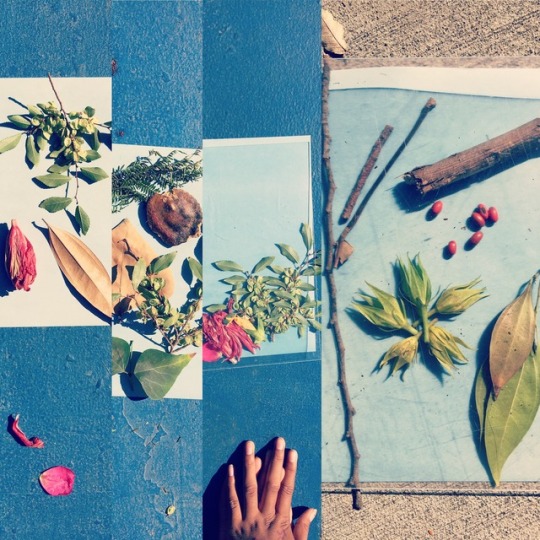
Title: Collective Process
by Raymundo Baltazar-Flores
The three articles utilized the word, process, to describe the importance of arts programs in prisons, as an integral part of being a teaching artist and how processes can render creative solutions to complicated problems.
As a word, process alludes to the creation of something: an object, a work of art or the liminal state between beginning and end. Process, as a communicational tool also has the power to create meaning. In other words, once we hear the term process, we understand that at some point, such process will render something tangible. However, processes can have a myriad of outcomes and regardless if a process is streamed lined, -think Ford’s assembly line, - a collective need is required to ensure that such process renders the same outcome, all the time. As mentioned in the article “beginners guide to community-based arts,” collective process is extremely important when embarking in the transformation of “communities through art” (1).
The photograph’s attempt is to visualize such collective process.
The photograph is a collage of different photographs, sliced side by side to represent one idea- through various processes. As part of a lesson for an after-school arts program, these images reflected the different approaches that the students took. Though they all had the same instructions and materials, every shadow-making-print would ultimately be different. As I reflected, I noticed that when I placed these images side by side, the approach taken by each student might have seemed similar but when such images were placed as a collective, I immediately saw how different they truly were. It is that idea that reminded me of Larry Brewster’s “The Impact of Prison Arts Programs on Inmate Attitudes and Behavior: A Quantitative Evaluation;” that arts education provides a very important “creative process [that] often has the added satisfaction of having something to show for your hard work—a poem, essay, or novel, drawing or painting, a play or concert performed” (Brewster, 3). Through his own research, he had to create something to show (graphics/charts) so the readers, could understand complex data. Also, as mentioned in the “Development Guide for Excellence in Teaching Artist Practice,” through process, a teaching artist can create “relevant connections in, through, and about the arts” if they balance their attention between process and product (1). Further, through the video “Mass Incarceration, Visualized” the short presentation illustrated how process has entrapped specific minorities; a process of marginalization that has become a cycle of incarceration whose rates keep on affecting, not just the offender but rather the entire cultural process of the U.S.A.
0 notes